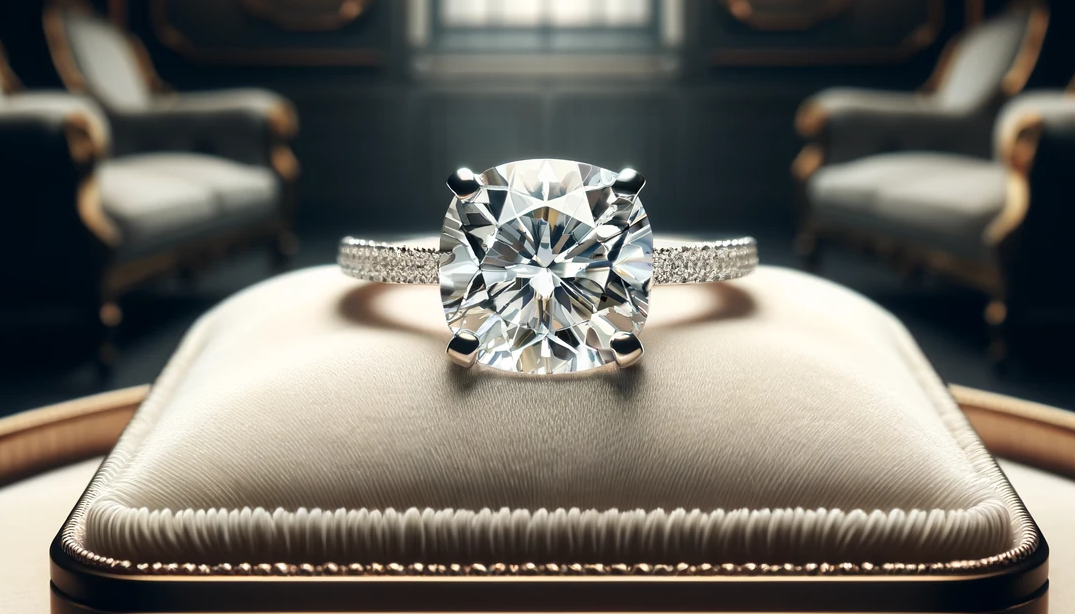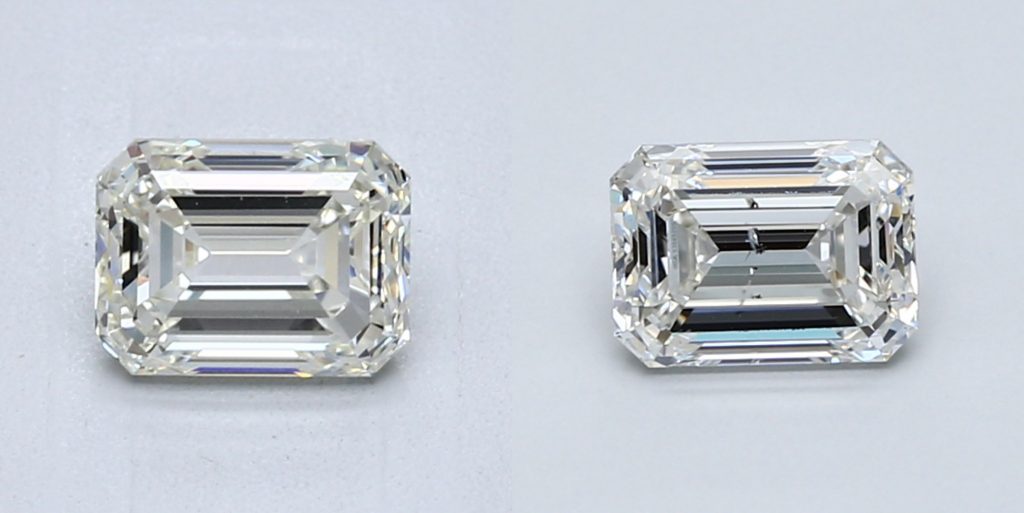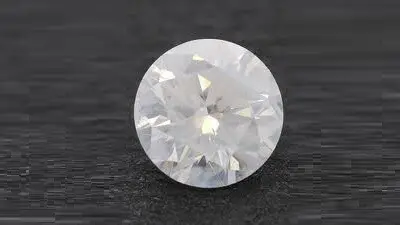Eye Clean Diamonds: The Ultimate Balance In Clarity

By Gary A.

Edited by Olivia H.
Published Jul 29, 2022
Edited on Dec 17, 2024
When searching for that perfect engagement ring, knowing how to find an eye clean diamond can make all the difference in balancing beauty and budget.

- 7 Quick Tips for Examining Eye-Clean Diamonds in Engagement Rings
- Introduction
- Decoding the Mystery of Eye Clean Diamonds
- The Importance of Eye Clean Diamonds
- Navigating Diamond Grading Scales
- Essentials for Examining Eye Clean Diamonds
- Our Expert Take
- 9 FAQs
Before we dive deeper into the specifics, here are some practical tips to help guide your decision-making process:
7 Quick Tips for Examining Eye-Clean Diamonds in Engagement Rings
- Tip 1:Understand the Clarity Grade Spectrum:
Begin by familiarizing yourself with the GIA clarity grading scale. While grades like FL (Flawless) and IF (Internally Flawless) indicate the highest clarity, eye-clean diamonds often fall within the VS (Very Slightly Included) and SI (Slightly Included) categories. Knowing where these grades lie on the spectrum helps you make an informed decision. - Tip 2:Perform a Visual Inspection Under Different Lighting:
Examine the diamond under various lighting conditions. Natural daylight is best for spotting any visible inclusions or blemishes. Also, observe the diamond under indoor lighting, as different light sources can reveal different aspects of the diamond’s clarity. - Tip 3:Distance Test for Eye-Cleanliness:
Hold the diamond at a standard distance, approximately 6-12 inches away from your eyes, which is the typical range for observing an eye-clean diamond. Rotate it slowly, checking from various angles. If you can’t see any inclusions or blemishes with the naked eye at this distance, the diamond is considered eye-clean. - Tip 4:Compare Diamonds Side-by-Side:
If possible, compare multiple diamonds side-by-side. This comparison can give you a better perspective on the clarity differences between various stones and help you understand what level of eye-cleanliness is acceptable to you. - Tip 5:Focus on the Diamond’s Table and Center:
Pay special attention to the center and table (the flat top) of the diamond, as inclusions here are more noticeable and can impact the overall appearance more significantly than those located towards the edges or the bottom. - Tip 6:Assess the Size and Shape Factor:
The size and shape of the diamond play a crucial role in clarity perception. Larger diamonds and certain shapes like emerald or asscher cuts may require a higher clarity grade to appear eye-clean compared to smaller or more brilliant cuts like round or cushion. - Tip 7:Consider the Setting and Style of the Ring:
The design of the ring can influence the perception of the diamond’s clarity. Certain settings can hide minor inclusions, especially those located at the edges. The overall style of the ring should complement the diamond’s clarity to enhance its beauty.
Now that you’ve got these practical tips, use Jeweler AI below to find the perfect engagement ring that suits your style and budget:
Introduction
It doesn’t take a lifelong diamond enthusiast to confirm that, whenever the subject is on the cards, the phrase ‘eye clean’ is never very far from anyone’s lips.
And, while it might sound self-explanatory at first, it can be a little confusing to work out how much of an emphasis you want to place on it, when so much of your attention is being pulled toward the Four Cs instead. Fortunately, there is a way of using your knowledge about the Four Cs alongside your understanding of eye cleanliness – and it’s the secret to finding the perfect diamond for your engagement ring.

Decoding the Mystery of Eye Clean Diamonds
But what is an eye clean diamond? An eye clean diamond is a diamond that appears flawless to the naked eye from a short distance (about 6-12 inches). It may contain imperfections, though, that are visible only under magnification. They have a high value, but remain much, much lower in price than flawless diamonds – and that’s precisely why you’ll want to hold it front and center in your mind going forward and know the match-up of an eye clean vs not eye clean diamond.
Eye clean VS visibly included – Emerald cut diamonds
The Importance of Eye Clean Diamonds
For two reasons. First of all, to ensure the most beautiful diamond possible, and to avoid ruining your engagement ring with visible inclusions. Secondly, to make sure that you’re not overpaying for features that won’t be visible once the diamond is away from the jeweler’s magnifying glass.
We mentioned above that flawless diamonds are super valuable. They’re rare and, to the right collector, fascinating enough to demand a price that would seem much too high to the rest of us.
For the casual shopper looking to create a beautiful engagement ring (or any other piece of jewelry), there’s simply no point in paying that much money, since identifying any real difference between a flawless diamond and an eye clean diamond requires strong magnification and, potentially, a skilled eye who can accurately articulate the answer to ‘what is an eye clean diamond?’. A small diamond with IF clarity won’t look as impressive as a larger, eye clean diamond, even if that diamond had a clarity grade as low as VS2 or SI1.
Essentially, focusing on eye cleanliness is your ticket to finding the biggest and most beautiful diamond in your price range.

Navigating Diamond Grading Scales
As you no doubt know, diamonds are graded on their 4 Cs: color, cut, carat and their clarity. The clarity of a diamond is graded based on its appearance under 10x magnification, the significance of any inclusions or blemishes under magnification and the naked eye, and how many inclusions or blemishes it has.
A diamond’s clarity will have a significant impact on its value and overall price.
The Significance of GIA Standards in Diamond Selection
The diamond clarity scale devised by the GIA contains the following grades:
- Flawless (FL)
- Internally Flawless (IF)
- Very Very Small Inclusions 1 (VVS1)
- Very Very Small Inclusions 2 (VVS2)
- Very Small Inclusions 1 (VS1)
- Very Small Inclusions 2 (VS2)
- Small Inclusions 1 (SI1)
- Small Inclusions 2 (SI2)
- Inclusions 1 (I1)
- Inclusions 2 (I2)
If you’re wondering why a grade specifically for eye clean diamonds is missing from the clarity scale, you wouldn’t be the first. However, eye clean diamonds are present throughout the clarity spectrum – barring the very lowest grades – and can be found in various grades, such as SI1 or VS2.
Finding the Right Balance
As you might have guessed by now, there is no definitive cut-off point on the GIA clarity scale where diamonds can no longer be eye clean – meaning the eye clean diamond clarity has a large scope. Smaller SI1 diamonds can be eye clean, while larger VS2 diamonds won’t be. Some shapes, like the Emerald, will offer a little less leeway than, say, the Round or Cushion cut.
For those wondering is vs2 eye clean, consider the following: According to GIA standards, diamonds that are graded Flawless (FL), Internally Flawless (IF), Very, Very Slightly Included (VVS1 and VVS2) and Very Slightly Included (VS1 and VS2) are considered diamond eye clean, which offers plenty of options to any shopper – answers the question of are vs2 diamonds eye clean.
Essentials for Examining Eye-Clean Diamonds
There is a very simple way to check if a diamond is eye clean or not: look at it!
Hold the diamond around 6-12 inches away from your face, looking at the diamond face up. Move the diamond slowly back and forth, and if you don’t see any blemishes – such as cloudy white areas, black spots, cracks, white spots, or strange lines – then it’s an eye clean diamond.
Of course, you can’t do this through a computer screen – and that’s one of the main reasons why we impose such a rigorous quality check on each diamond we list on our site. Unlike other online sellers, we invest considerable time into this QA process on behalf of our customers, to avoid any disappointment down the line.
How Different Diamond Shapes Impact Eye Cleanliness
Diamond shapes that naturally feature larger, more open tables (that’s the large, flat facet you see when you’re viewing the diamond from above) will show inclusions more easily than diamonds that feature smaller tables.
For instance, the Emerald and Asscher cuts both feature quite a large table – and, generally, longer and more ‘open’ facets. In the modified brilliant shapes and, of course, the Round Brilliant, the facets are smaller and more intricately placed, offering more obscurity to inclusions.
For this reason, those shopping for Step Cuts should aim to hit the VS section of the clarity scale for the best value and beauty.

Balancing Budget and Beauty in Diamond Selection
When purchasing an eye clean diamond, it is important to buy the lowest clarity diamond that is still eye clean. For most people, this means starting at a eye clean diamond grade of around SI2 or SI1, and adjusting depending on the size and shape of diamond you’re looking for. Remember there is not cut-off point for eye clean diamond clarity.
Our Expert Take
Eye cleanliness is definitely worth a lot of attention, yes. It’s all too easy for an otherwise beautiful diamond to be totally ruined by a major inclusion, and a diamond like that is not worth paying for.
In an ideal world, it would be possible to cut inclusions away from any diamond, and to still have a beautiful stone by the end of it. In reality, however, it’s just not possible. In some rough stones, the arrangement or size of the inclusions mean that cutting them away is impossible, or that doing so would yield a very, very small diamond.
This works for some people but, in an engagement ring, where all attention is pointed toward that stone at its center, a visibly included diamond is not worth the minor savings involved. Eye clean diamonds are available at most of the eye clean diamond clarity grades, meaning that they’re available at practically any price point – and by far the best bet for you.
View more VS2 and SI1 – SI2 diamonds here
9 FAQs
- Q: What exactly is an ‘eye-clean’ diamond?
A: An eye-clean diamond is one that appears flawless to the naked eye from a normal viewing distance, typically 6-12 inches. Any inclusions or blemishes are not visible without magnification. - Q: How can I determine if a diamond is eye-clean?
A: To assess if a diamond is eye-clean, hold it about 6-12 inches from your eye and inspect it in good lighting. If you can’t see any visible inclusions or marks with the naked eye, it’s considered eye-clean. - Q: Are VS2 diamonds always eye-clean?
A: While most VS2 diamonds are eye-clean, it’s not a guarantee. Factors like the size and location of inclusions, as well as the diamond’s shape, can affect its appearance. - Q: Does the shape of the diamond impact its eye cleanliness?
A: Yes, the shape can impact how inclusions are visible. For example, step-cut shapes like Emeralds and Asschers tend to show inclusions more readily than round or cushion cuts. - Q: Is it worth paying extra for a flawless diamond over an eye-clean one?
A: For most consumers, an eye-clean diamond offers better value. Flawless diamonds are significantly more expensive, and the differences are not noticeable to the naked eye. - Q: Can SI1 diamonds be eye-clean?
A: Yes, many SI1 diamonds are eye-clean. However, it depends on factors like the size and placement of inclusions. - Q: What impact does fluorescence have on an eye-clean diamond?
A: Fluorescence can sometimes mask or highlight inclusions, but in many cases, it doesn’t impact the eye cleanliness of a diamond. It’s more of a personal preference. - Q: How important is the diamond’s size when considering eye cleanliness?
A: Size is an important factor. Larger diamonds have larger facets, which can make inclusions more visible. Therefore, what is eye-clean in a smaller diamond might not be in a larger one. - Q: Should I rely solely on a diamond’s certificate to determine eye cleanliness?
A: A certificate is a useful guide, but it shouldn’t replace personal inspection. Always view the diamond yourself to assess its eye cleanliness.
Discover your perfect eye-clean diamond with Jeweler AI – where precision meets passion in every engagement ring choice.
FOLLOW-UP GUIDE SERIES





















